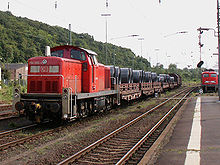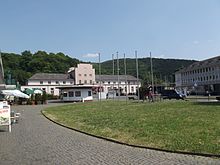Dillenburg station
| Dillenburg | |
|---|---|

|
|
| Data | |
| Location in the network | Intermediate station |
| Design | Through station |
| Platform tracks | 5 |
| abbreviation | FDIL |
| IBNR | 8000074 |
| Price range | 4th |
| opening | 1862 |
| Profile on Bahnhof.de | Dillenburg |
| location | |
| City / municipality | Dillenburg |
| country | Hesse |
| Country | Germany |
| Coordinates | 50 ° 44 '6 " N , 8 ° 17' 40" E |
| Railway lines | |
|
|
| Railway stations in Hessen | |
The Dillenburg station is a through station on the Dill Railway in the central Hessian town of Dillenburg .
Geographical location
Immediately adjacent to the train station is the central bus station , from which bus lines connect the surrounding area. Together they form the hub of local public transport in Dillenburg.
history
development
Dillenburg station was opened together with the line in 1862. In 1972 the Dillenburg– Wallau (Lahn) Schelden Valley Railway and in 1892 the Dillenburg– Ewersbach Dietzhölztal Railway was added.
Passenger traffic on the two branch lines was discontinued in 1987. Until the bus station was built in the late 1980s , there were stump tracks 24, 25 and 26, of which only track 24 was accessible via a platform . As a rule, trains to Niederwalgern left from there.
In 1983 the former Dillenburg depot , which was once of great importance for the maintenance of the steam locomotives used in the region , was closed. The facilities are now dilapidated and the turntable has been removed. The freight yard also has extensive track systems to this day, but only about half of them are required for today's shunting operations.
Freight train accident on November 5, 2008
November 5, 2008 in the area of freight station a leading tank car -Güterzug into another freight train, which brand-new Porsche - sports car was loaded. The train driver of the tank car train was slightly injured, the property damage amounted to approx. 5 million euros. Over 20 sports cars fell from the wagons, and chemicals were not released from the tank wagons. Cause of the accident was that the duty Weichenwärterin has misidentified the track section concerned as free, although the rear car of the car transporter train still occupied the track.
Investments
Reception building
The reception building of the station originates in the core even of 1862. At that time a building was in Rundbogenstil built. Even before the First World War , a completely new building was planned, but the war prevented that. Even in the post-war period , money was tight, so that instead of a new building in 1925/26, extensive renovations and extensions took place. The historic building decor was removed, the profiles on the windows and doors chopped off, the round arches bricked up and square windows inserted and the historicizing gable replaced with a modern shape. The entrance building appears to be expressionist today . The building is a cultural monument according to the Hessian Monument Protection Act . There were still ticket offices in the station building until the 2000s, but today tickets can be purchased from machines and in the building's own DB store, which was newly established in the early 2000s. Once there was also a train station restaurant in the building, but it has been closed for more than 15 years.
Platforms
There are five platform tracks on one house platform and two central platforms . All platforms are partially covered. Another platform in the east, which was used by the trains on the branch lines, is still there, but has no tracks and is largely overgrown. The platforms are connected by an underpass . Access to the easternmost platform is no longer possible today.
Signal box
The train and shunting movements in the area of the Dillenburg train station are now controlled by three electromechanical signal boxes. Still in operation are the dispatchers - interlocking Df (Dillenburg dispatcher) and the two points guards -Stellwerke Dn (Dillenburg Nord) and Ds (Dillenburg South) . Of the other signal boxes in the area of the freight yard, the signal box Dr (Dillenburg marshalling yard) was last abandoned. The entry, intermediate and exit signals in the area of the Dillenburg train station are still designed as form signals, but their pre-signals were completely converted to light pre-signals in the early 1990s .
meaning
passenger traffic
Regional Express trains (RE 99), the Mittelhessen Express (RB 40) and regional trains (RB 95 and RB 96) stop at Dillenburg station . With the exception of a few deviations, the trains regularly depart from the following tracks:
| line | Line course | Tact | Control track |
|---|---|---|---|
| RE 99 |
Main-Sieg-Express : Siegen Hbf - Haiger - Dillenburg - Herborn (Dillkr) - Wetzlar - Gießen - Friedberg (Hess) - Frankfurt (Main) Hbf Between Gießen and Frankfurt only 120-minute intervals As of: timetable change December 2015 |
60 min | 3 (towards Herborn) 4 (towards Haiger) |
| RB 40 |
Mittelhessen-Express : Dillenburg - Herborn (Dillkr) - Ehringshausen (Kr Wetzlar) - Wetzlar - Gießen - Butzbach - Bad Nauheim - Friedberg (Hess) - Frankfurt (Main) West - Frankfurt (Main) Hbf |
60 min | 1 |
| RB 95 |
Sieg-Dill-Bahn : Siegen Hbf - Wilnsdorf-Rudersdorf - Dillbrecht - Rodenbach (Dillkr) - Haiger - Sechshelden - Dillenburg Status: timetable change December 2015 |
60 min | 2 |
| RB 96 |
Hellertal Railway : Betzdorf (Sieg) - Herdorf - Neunkirchen (Kr Siegen) - Burbach (Kr Siegen) - Haiger - Dillenburg Between Neunkirchen and Dillenburg only 120-minute intervals As of: timetable change December 2017 |
60 min | 5 |
In the past there were also some long-distance connections to many parts of the Federal Republic on an express train basis. With the introduction of the Interregio , the IR line 22 ran Frankfurt (M) - Münster via Dillenburg, later this ran from Hagen to Düsseldorf instead of Münster. A pair of trains drove daily from Münster via Rheine and Emden to Norddeich Mole station . With the Interconnex , Dillenburg was also connected to the capital Berlin for the first time . The Eurocity EC 112 operated between 2009 and 2011 from Siegen to Klagenfurt via Herborn, Wetzlar, Gießen, Bad Nauheim, Frankfurt, Darmstadt, Heidelberg, Stuttgart, Ulm, Augsburg, Munich, Salzburg and Villach. This was the first international passenger train from Dillenburg. These trains also contained through coaches to Zagreb . At the moment there is no longer any long-distance traffic via Dillenburg. However, in the next few years an intercity line Frankfurt-Münster will be set up based on the model of the old interregio line, which will then also serve Dillenburg.
Freight transport

The station is divided into two parts: the passenger station and, to the south, the freight station . The building of the freight yard from 1916 consists on the one hand of a villa-like building for the administration with a very large roof. The roof is two-story and dominates the one-story structure. On the other hand, the building consists of the goods hall attached to this administrative building. It is a listed building .
In the freight station, the regional freight traffic from the Haiger and Dillenburg stations is collected and connected to the national freight network via the Wetzlar and Kreuztal freight stations. In addition, the Dillenburg freight yard is very important for the supply of the local ThyssenKrupp Nirosta steelworks , mainly with steel coils to be refined , which are delivered every day except Thursday in a block train from the Ruhr area (especially Bochum ). A class 294 locomotive is assigned to Dillenburg every day to handle the shunting tasks .
service
The bus station is in the immediate vicinity of the train station. All local and regional bus routes stop there, so that you can not only change to the train, but also between bus routes. There is also a taxi rank and short-term parking spaces on the station forecourt . There is also a park-and-ride car park south of the bus station for long-term passengers.
Web links
|
←
|
Lines |
→
|
||
|---|---|---|---|---|
| Haiger |
Main-Sieg-Express |
Herborn (Dillkr) | ||
| Beginning |
Mittelhessen-Express |
Niedereld (Dillkr) south |
||
| Six heroes |
Sieg-Dill-Bahn |
The End | ||
| Six heroes |
Hellertalbahn |
The End | ||
Remarks
- ^ The information given by Heinz Schomann : Railway in Hessen . Railway history and building types 1839–1999 / Railway buildings and lines 1839–1939. In: State Office for Monument Preservation Hessen (Ed.): Cultural monuments in Hessen. Monument topography Federal Republic of Germany . Three volumes in a slipcase. tape 2.1 . Theiss Verlag, Stuttgart 2005, ISBN 3-8062-1917-6 , p. 269 . that it is a completely new building is not correct.
Individual evidence
- ↑ Query of course book route 445 at Deutsche Bahn.
- ↑ Grossart: The development of the railway buildings in the Rhine-Main area . In: Die Reichsbahn 16 (1940), pp. 200-215 (210f).
- ^ Heinz Schomann : Railway in Hessen . Railway history and building types 1839–1999 / Railway buildings and lines 1839–1939. In: State Office for Monument Preservation Hessen (Ed.): Cultural monuments in Hessen. Monument topography Federal Republic of Germany . Three volumes in a slipcase. tape 2.1 . Theiss Verlag, Stuttgart 2005, ISBN 3-8062-1917-6 , p. 269 .
- ^ Heinz Schomann : Railway in Hessen . Railway history and building types 1839–1999 / Railway buildings and lines 1839–1939. In: State Office for Monument Preservation Hessen (Ed.): Cultural monuments in Hessen. Monument topography Federal Republic of Germany . Three volumes in a slipcase. tape 2.1 . Theiss Verlag, Stuttgart 2005, ISBN 3-8062-1917-6 , p. 270 .


